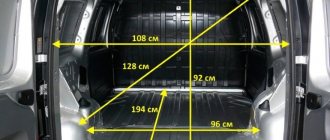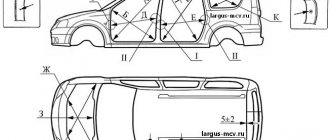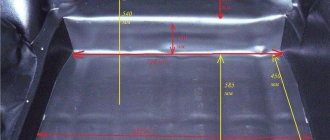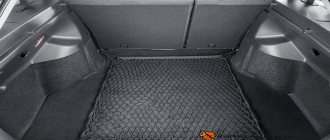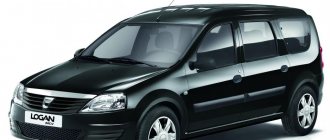What is the carrying capacity of the Lada-Largus: comparison with competitors
The certified carrying capacity of all modifications of the Lada Largus, calculated as the difference between the curb and gross weights of the vehicle, has the following values:
- 445 kg for a 5-seater station wagon;
- 480 kg for the 7-seater version and for Largus Cross;
- 750 kg for a van.
Undoubtedly, the characteristics are impressive for a B-class family car, and the Largus van is comparable to the capabilities of representatives of the commercial LCV segment, such as the GAZ-2752 Sobol.
However, considering cargo capabilities only in terms of payload is not entirely correct. After all, humanity invented trucks to transport cinder blocks and floor slabs. And for a typical station wagon owner, the most important thing is to answer the question of whether he can carry ten packs of insulation at a time, and whether a two-meter refrigerator will fit into the cabin.
Therefore, it is possible to more objectively assess the cargo capabilities of the Lada Largus based on the volume of the luggage compartment and its dimensions (depth, width and height).
In addition, we should not forget about the price component: the Audi allroad station wagon with a three-liter engine has a comparable maximum load capacity of 500 kg, but the cost is equal to 8.5 Largus.
Volume and dimensions of the luggage compartment of the Largus family
So, we present the contenders for the championship title in the category “The most spacious trunk for 500 thousand rubles”:
The 5-seater Lada Largus with a load capacity of up to 445 kg, according to official information from AvtoVAZ, has a luggage compartment with a volume of 560 liters. With the rear row seats folded down, 2,350 liters of usable space are available to accommodate cargo.
The linear dimensions of the compartment have the following values:
- Trunk length 90 cm or 174 cm (to the level of the backs of the front seats);
- Actual compartment width 134 cm;
- The height of the rear door opening is 92 cm.
In the 7-seater modification of the Lada Largus, the load capacity declared by the manufacturer is increased by 35 kg compared to its 5-seater brother due to the reinforced suspension. The trunk is designed for 135 liters of cargo. By folding the backrests of the third row of seats, you can increase the luggage volume to 560 liters. A maximum capacity of 2,350 liters is provided when all rows of seats except the first are folded down. The Lada Largus Cross also shows similar load capacity parameters.
The following video describes the procedure for dismantling the right-side seats for transporting cargo over two meters long:
Warning! Stowing cargo above the openings of the side and rear windows seriously impairs visibility. Be careful when driving so as not to get into an emergency situation.
Another unique modification of Largus is a van, suitable for transporting small quantities of various goods or for use as a traveling vehicle for repairmen, builders and other technical services.
The Largus cargo van has a load capacity of up to 750 kg. The length of the luggage compartment is 194 cm at floor level; at roof level the size is reduced due to the shape of the cabin partition. The floor distance between the rear wheel arches is 96 cm, the actual width of the cargo compartment is 134 cm. The width of the side door opening is about 61 cm.
Reminder! Unless absolutely necessary, you should not exceed the maximum load capacity established by the manufacturer, even if the luggage compartment space allows it. In this case, there is a high probability of damage to the vehicle’s suspension elements.
Cargo bay exterior
The car model, which was created in 2021, can first of all be compared with its station wagon brother, and the differences in body shape will be obvious:
- A rather practical solution in commercial terms is to paint the side mirrors and bumper of the car in black, and not in the main tone of the car, because when transporting cargo along country roads, there are often cases of dents and scratches that remain almost invisible against a dark background.
- The car is equipped with rear blind doors without glass. This design reduces the likelihood of damage to the surface of the transported cargo, even when driving on uneven roads.
Despite the large size of the cargo compartment of the Lada-Largus van, the car looks compact in appearance, which is a winning advantage.
Domestic B-class competitors
Among the products of the Russian automobile industry in the station wagon body are the Lada Priora and Lada Kalina 2 cars.
For the Lada Kalina 2 (VAZ 2194), the name “station wagon” rather informs about the body type than indicates serious load-carrying capacity. The luggage compartment capacity is 355 liters (with the rear row of seats folded - 670 liters), which is comparable to that of full-size sedans. Based on the dimensions of the Kalina platform, the linear dimensions of the luggage compartment are also very modest.
Foreign cars with comparable carrying capacity
If it is difficult to find a car with similar characteristics among ordinary station wagons, you should turn to neighboring classes.
5 and 7-seater options with a spacious trunk are typical for the MPV class, which unites minivans and high-capacity station wagons. Among the typical representatives are Renault Kangoo, Peugeot Partner, Fiat Doblo, Skoda Roomster, Volkswagen Caddy.
Without focusing on the significantly higher cost of these vehicles, we will conduct a comparative analysis of their cargo capabilities:
- Renault Kangoo is available as a 5-seater minivan with a payload of 451 kg and a van with a payload of 592 kg. Luggage compartment volume ranges from 660 liters as standard to 1,524 liters for vans and minivans with the rear seats folded down.
- The Skoda Roomster is designed for 5 seats and can accommodate from 450 to 1555 liters of luggage weighing 455 kg.
- Peugeot Partner in minivan format (5 seats) with a luggage compartment of up to 2800 liters and in a van modification of up to 2830 liters can carry up to 600 kg of luggage.
- Volkswagen Caddy for 5 or 7 passengers takes up to 665 kg of cargo in the trunk. The volume of the compartment, depending on the configuration of the seats, ranges from 750 to 3300 liters. The Caddy Maxi van with an extended wheelbase has a luggage compartment volume of 4.2 m3.
Station wagon, minivan and van - are there any differences inside the cars?
Many car enthusiasts know that the Lada Largus is available in three body styles: station wagon, minivan and van. The options do not have any special differences, except for one “but” - they have a different number of seats:
- The standard station wagon has 5 seats and a medium-sized trunk (560 liters).
- The extended station wagon, also known as a minivan, has 7 seats and a small trunk (170 liters).
- The van has only 2 seats - one for the driver, the other for the front passenger. This Largus variation has an extended trunk (about 2000 liters), which is needed for transporting large cargo.
Apart from the number of seats, there are no differences in the interior design of all variants of the Lada Largus. The general concept of the interior is determined based on the selected configuration:
- in cars with a budget set of options, the interior has an “economy class” character, featuring standard AvtoVAZ upholstery: fabric seat covers and a lot of plastic;
- in models with a more “advanced” set of options, the interior is necessarily complemented by leather upholstery of the steering wheel, seats and some parts of the interior upholstery; in addition, in the interior design you can find various multimedia additions and upgraded components of standard equipment.
Important! The general interior concept for all variations of the Lada Largus is the same. The final design format is determined not by the chosen body option, but by the specific configuration.
Modifications of Lada Largus van
| 1.6 l Renault K7M 84 hp 124 Nm and 5-speed Renault JH3 |
| 1.6 l Renault K4M 102 hp 145 Nm and 5-speed Renault JR5 |
| 1.6 l VAZ 11189 87 hp 140 Nm and 5-speed Renault JR5 |
| 1.6 l VAZ 21129 106 hp 148 Nm and 5-speed Renault JR5 |
AvtoVAZ promised to soon replace the Renault gearbox with the domestic VAZ 21809.
We have a separate and very detailed material about all Largus power units
For several years now, this van has been tested in the park of ZaRulem magazine.
ARTICLE
A detailed description of this car can be found on the Largus-MCV portal
PDF
On the manufacturer's website you can download the current user manual
Rear cabin
Of course, the front part of the cabin of any car is more interesting to consider, since it is a kind of transport control center. Despite this, when studying the interior of the Lada Largus, it would be a crime to ignore a detailed examination of the rear of the cabin. To be fair, we note that there is something to see here too.
To begin with, let us remind you that in Largus the rear part of the cabin can be:
- or 5 armchairs (three and two of them are made as separate solid sofas);
- or 3 armchairs (made as a solid sofa);
- or a regular luggage compartment with a large capacity.
A pleasant difference between any organization of the rear part of the interior of the Lada Largus is that it is quite spacious. Moreover, any owner of this model, if desired, can remove the rear seats and personally turn his car into a van. Photos of the Lada Largus interior with 5 seats and 7 seats illustrating this concept are presented below.
The rear seats in Largus have comfortable head pillows for passengers, integrally built into the seat frame. There are standard seat belts on the sides of each seat. The rear doors are required to have armrests. In addition, the rear part of the cabin is filled with a considerable number of pockets, cup holders and similar containers for passengers’ belongings, which is simply good news.
The specific interior design in this area of the car is also determined based on the selected configuration of the Lada Largus and is similar to the front part (see photo below).
Important! The rear part of the cabin in Largus does not have any specific features, but it is made of very high quality and competently, which allows passengers to move comfortably in the car and behind it.
Ease of use
The practicality of the car is perfectly combined with a high level of comfort. The Lada-Largus van has a modern air conditioner and audio system, heated front seats, central locking, electric windows and other useful options that are a significant contribution to the profitability of the business. This is explained by the fact that driver comfort affects the success of transportation.
In addition to the above advantages, Lada-Largus has the following options:
- Power steering.
- The glove box is large.
- Pockets in the front doors for storing small items.
- The center console is ergonomic.
- A lighting point is integrated into the luggage compartment.
The car has high cross-country ability: ground clearance without load is 18.1 cm, with full load - 14.5 cm. The gear ratios in the gearbox are selected specifically for the cargo model.
